Oxalis, also called oxalis, is part of the acid family, and this genus is represented by perennial and annual herbaceous plants. Under natural conditions, oxalis is found in South Africa, South and Central America, and also in Europe. In Ireland, it is a national symbol, the Saint Patrick plant, considered the most revered righteous man in the country. From Latin "oxys" translates as "sour", this is due to the fact that the foliage of such a plant has a sour taste. In natural conditions, there are about 800 species of oxalis. Some of these species began to be cultivated in the 17th century, and from that very time they have been grown both at home and in the open field. In European countries, this plant is also called "clover of happiness", and in Russia - "hare cabbage". The high popularity of acid plant among gardeners and florists is explained by the fact that it is a highly decorative and undemanding plant to care for.
Content
Brief description of cultivation
- Bloom... From the last days of May or from the first - June until winter.
- Illumination... A bright light is needed, which must be necessarily diffused.
- Temperature regime... During the growing season, the air temperature should be in the range from 20 to 25 degrees, and during the rest period - from 12 to 18 degrees.
- Watering... In the spring and summer, watering should be abundant, and in the cold season - from moderate to scarce.
- Air humidity... It grows well with air humidity, which is typical for living quarters, but if the room is too hot, then sometimes moisten the foliage with a spray bottle.
- Fertilizer... During intensive growth, top dressing is carried out 1 time in 15–20 days, for this purpose, mineral complex fertilizers are used in half the dosage recommended by the manufacturer.
- Dormant period... It starts after flowering and lasts 4–6 weeks.
- Transfer... Young bushes are transplanted every year, and adults - once every 2 or 3 years.
- Reproduction... Most often, nodules or daughter bulbs are used, and more rarely, the seed method.
- Harmful insects... Aphids, scale insects and spider mites.
- Diseases... Fusarium and gray rot.
- Properties... This plant has medicinal properties, its foliage contains a large amount of vitamin C.
Features of sour
As mentioned above, the oxalis genus includes a large number of species, among which there are perennials, annuals, as well as bulbous and tuberous plants. Trifoliate or palmate petiolate leaf plates with a complex limb open in the morning and fold in the evening. Foliage also reacts to mechanical irritation or to very bright light. The foliage can be purple, green or burgundy. Small, regular-shaped flowers can be colored pink, yellow, white or lilac. Like foliage in the evening or before bad weather, the flowers close. Ripe seeds are in a shell that breaks at the slightest touch. Most often, triangular acid and four-leaved acid is grown in room conditions. In Europe, room acid is very often used as a gift for a Christmas tree, because there is such a sign that if such a flower settles in the house 1 day before the New Year, it will bring prosperity and happiness with it.
Sour acid care at home
Illumination
In order for the cultivation of sour cherry to be successful, it needs to create conditions that are as close to natural as possible. She needs a lot of bright light, but it must be diffused. Never allow direct sunlight to hit the foliage.
Temperature regime
In the warm season, the flower prefers to be at an air temperature of 20 to 25 degrees. In winter, it is removed to a cooler place, if this is not done, then flowering may not come.
Watering and spraying
In the spring-summer period, water the plant abundantly, but at the same time, do not allow liquid stagnation in the root system of the bush. In the autumn, watering is reduced, and in the winter months, watering should be meager and rare, but it is impossible to allow a complete drying out of a clod of earth in a pot.
Oxalis grows and develops normally without regular spraying of foliage from a spray bottle. But if the room is very hot and stuffy, then spraying the flower will be very useful, for this they use cold pre-boiled water. However, you cannot moisten the flower in winter.
Dormant period
In some species of oxalis, a dormant period is observed in winter, the duration of which is from 4 to 6 weeks. Watch the sour, when it finishes blooming, if foliage begins to fly around in large quantities, then you should reduce watering and remove it to a cooler place where it will stay until the end of the dormant period. However, in some cases, the foliage does not fly around, and the plant simply stops growing, in this case, it also needs to be removed to a cool place so that it has a good rest. Watering the bush at this time is very rare and with a small amount of water, but the clod of earth in the pot should not dry out. Immediately after young shoots begin to grow, the flower is transplanted into a new soil mixture and returned to its usual place, while watering is resumed and do not forget to feed it in a timely manner.
Top dressing
Room acid must be systematically fed, using mineral complex fertilizer for this. Top dressing is carried out during the growing season and flowering with a frequency of 1 time in 15–20 days, while using a nutrient solution of such a concentration, which will be half the recommended by the manufacturer (see the package).
Sour acid transplant
While the flower is young, it needs to be transplanted once a year, older specimens are subjected to this procedure much less often, namely, once every 2 or 3 years. Before starting to transplant a plant, you need to choose a suitable container. Experienced flower growers recommend using a wide pot, as in this case several bulbs and tubers will fit in it, as a result of which a spectacular lush bush will decorate your home. To avoid stagnation of liquid in the root system, a good drainage layer must be made at the bottom of the container. This plant does not differ in its exactingness to the soil mixture, therefore, for its transplant, you can buy a ready-made universal soil mixture, or you can compose it yourself, for this, combine sand, sod, leafy and peat soil, which are taken in equal shares. However, when choosing a soil mixture, one must take into account the fact that if there are too many nutrients in it, then this will provoke a violent growth of foliage to the detriment of flowering. They transplant the bush very carefully and take it along with a lump of earth.


Watch this video on YouTube
Diseases and pests
Oxalis is highly resistant to diseases and various harmful insects. However, if it is weakened by improper care, then aphids, red spider mites and scale insects can settle on it. If aphids have settled on the plant, then it is treated with soapy water (for 2 tablespoons of water, 2 tsp of liquid soap), spider mites are removed with the help of Actellik. If he was attacked by a scale insect, then first the insects need to be removed from the flower with your hands, after which it is sprayed with Aktara. If necessary, after 7 days, the acid is re-processed. When using chemicals, do not forget about precautions: spraying the flower is carried out only in the fresh air, while wearing gloves and protecting the surface of the substrate in the pot from getting the drug on it. If the bush is treated with soapy water, then after a few hours it must be removed with clean water, and do not forget to also protect the surface of the soil mixture.
If a drainage layer was not made at the bottom of the pot when planting acid, then with excessively abundant watering in the root system, stagnation of liquid may be observed. This contributes to the development of fusarium or gray rot. Both of these diseases at the initial stage of development can be easily cured with Fundazole.
Reproduction methods
Seed propagation
Wild acidic species are propagated by seeds. However, this method of propagation is not often used by flower growers, since it is relatively long and ineffective. But if you have a desire to grow a flower from a seed, then you can try to do it. Step by step instructions for sowing seeds:
- Prepare a suitable potting mix first. It should include sand, peat and leaf humus (1: 4: 4).
- At the very beginning of spring, evenly distribute the seeds over the surface of the substrate, while you do not need to cover or sprinkle them on top with earth.
- Cover the container with glass (film), which will maintain the high humidity necessary for germination (about 100%).
- Rearrange the crops in a cool (16 to 18 degrees) and well-lit place, the light must be diffused. Make sure that the substrate in the container is a little damp all the time, for this you need to regularly water with a spray.
- Remember to ventilate your crops every day.
If everything is done correctly, the first seedlings will appear after 7-30 days (depending on the freshness of the seed).
Reproduction by daughter bulbs
It is much faster and easier to propagate a flower vegetatively. To do this, during transplantation near the bush, you need to carefully separate the daughter nodules or bulbs that have formed around the taproot. After that, several pieces of them are planted in one container and covered with a not very large amount of substrate on top.After that, the pot is removed in partial shade and do not forget to occasionally conduct moderate watering. When young shoots appear, the container is rearranged in a well-lit place, protected from direct sunlight, and after 4-6 weeks your house will already be decorated with an abundantly flowering lush bush.
Tuber division
Immediately after the end of the dormant period, when the first new leaf plate forms on the bush, the tuber must be removed from the pot and all the substrate removed from it. Rinse it carefully in a pinkish potassium manganese solution and divide it into several parts with a sharp, disinfected instrument. Places of cuts on the dividers must be sprinkled with coal powder, after which they are planted in individual pots. Then they are transferred to a well-lit place (the light should be diffused) and they are provided with regular watering, which is carried out immediately after the clod of earth in the pot dries out. Top dressing of delenoks is carried out 1 time in 15 days, while the first time fertilizers are applied a week after planting.


Watch this video on YouTube
Sour acid properties
It has been known for a long time that oxalis has medicinal properties. The aerial part of the bush was used for scurvy, as well as for treating wounds and ulcers, and also as an antidote for poisoning with mercury or arsenic. In alternative medicine, such properties of the flower as choleretic, wound healing, antihelminthic, anti-inflammatory and diuretic were widely used.
Since the foliage contains a lot of vitamin C, its use is recommended for colds, as well as for strengthening the body's immune system. Kislitsa is also widely used in cooking, so healthy and tasty tea is prepared from it, and it is also put in green borsch, cabbage soup or kvass.
Types of acid with photos and names
Triangular oxalis (Oxalis triangularis), or purple oxalis
This type is most popular with flower growers. It is a tuberous not very tall plant, the three-lobed long-petiolized leaves of which are decorated with specks of dark purple color. The leaves of such a flower are similar to the quivering wings of a butterfly, which is why it is also called “Madame Butterfly”. During flowering, small flowers are formed, which can be colored pinkish, white or lilac.
Four-leafed oxalis (Oxalis tetraphylla)
Or oxalis deppei. This type is cultivated both indoors and in the open field. Greenish four-lobed leaf plates have a middle brown-red color. Flowering lasts a relatively long time, during which inflorescences are formed, consisting of flowers of a raspberry-red hue. This species in England is also called "lucky clover".
Oxalis bowiei
This species is distinguished by its thermophilicity. The height of the bush is only about 20-25 centimeters, the leathery leaf plates have a greenish color, and the flowers on long peduncles are dark pink.
Common oxalis (Oxalis acetosella)
The height of such a rhizome plant is about 8-10 centimeters. The structure of the leaf plates is similar to clover. Single white flowers form on long peduncles.
Ferruginous oxalis (Oxalis adenophylla)
In this species, the bush can reach a height of about 10 centimeters. Its multi-lobed leaf plates are greenish-gray. And large pinkish flowers are decorated with veins and specks of a different color shade.
Multi-colored oxalis (Oxalis versicolor)
This species is highly decorative. During flowering, it is decorated with white flowers with red stripes. When the flower is opened, it is white inside, and a red border runs along the edge.
In addition to these species, the sour cherry Obtus, Oka (tuberous), carob, nine-leafed, poor, milky-white, nasturtium-shaped, succulent, jointed, pressed, triangular, etc. are also cultivated. However, all of them are grown in open ground.


Watch this video on YouTube

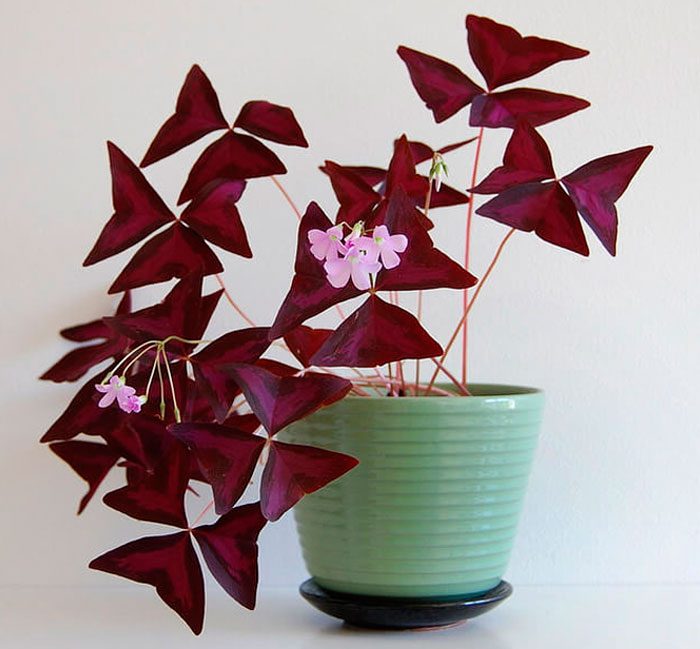
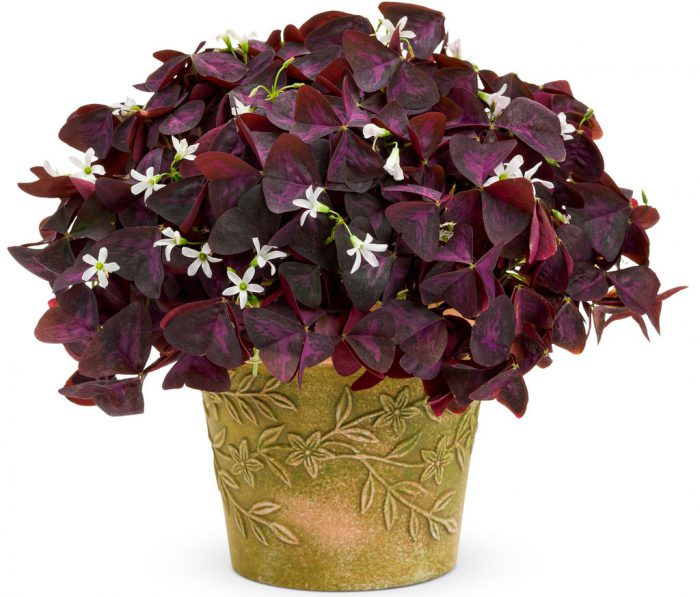
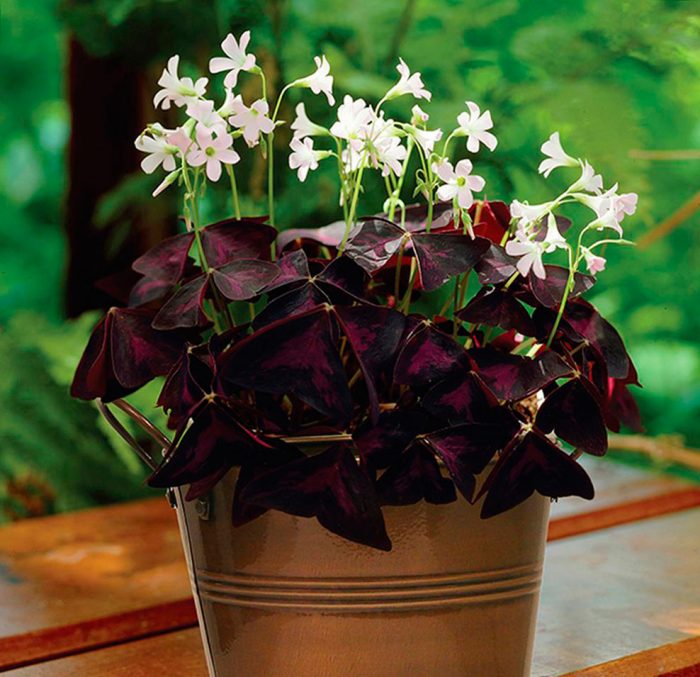
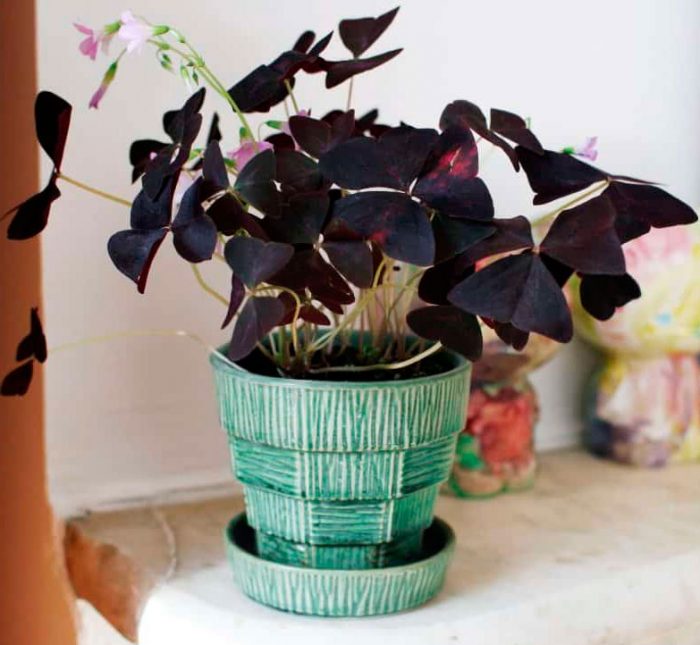
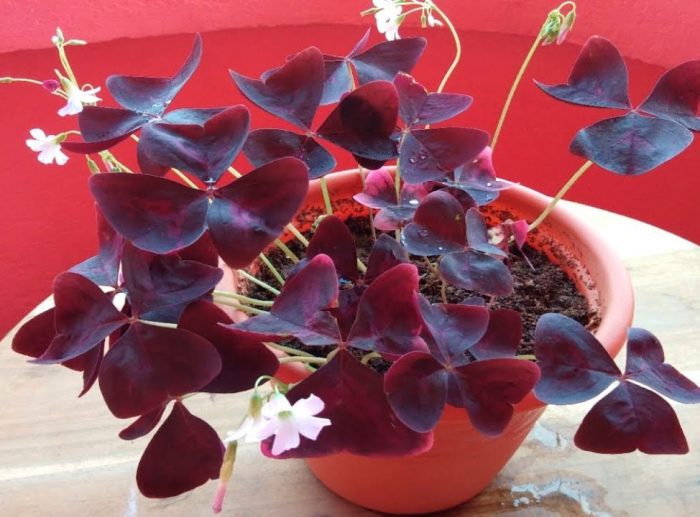
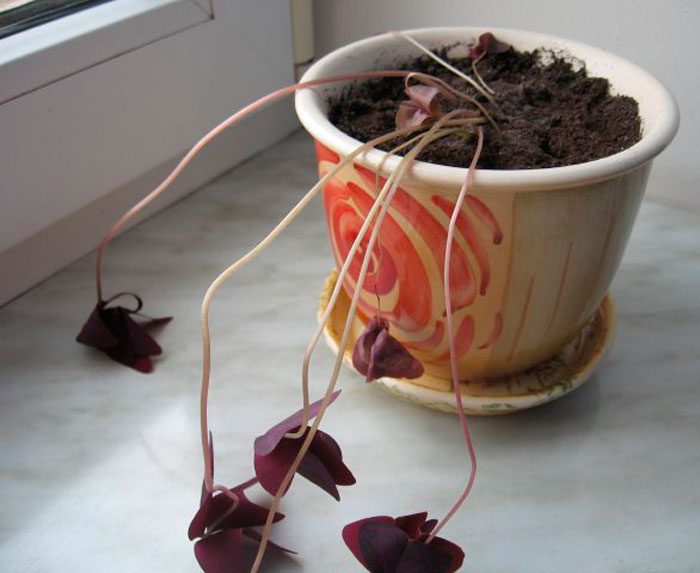
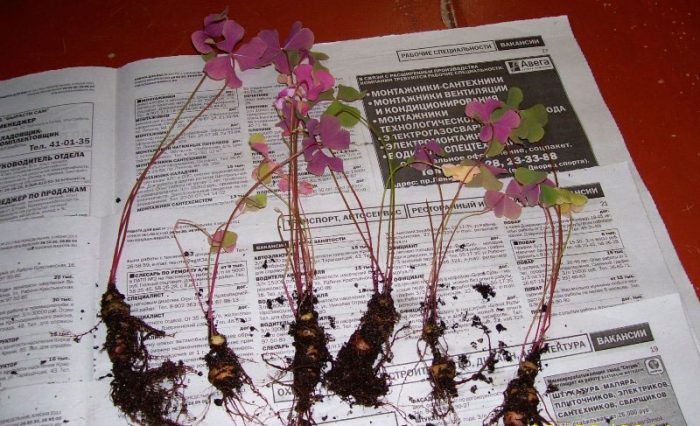
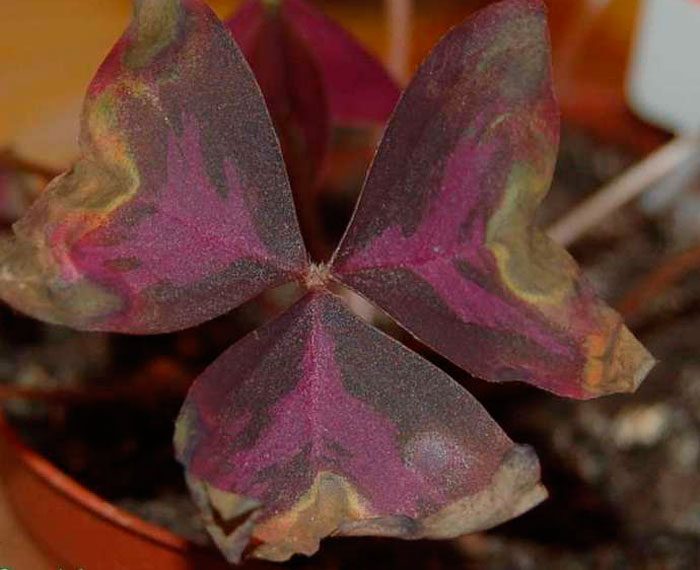
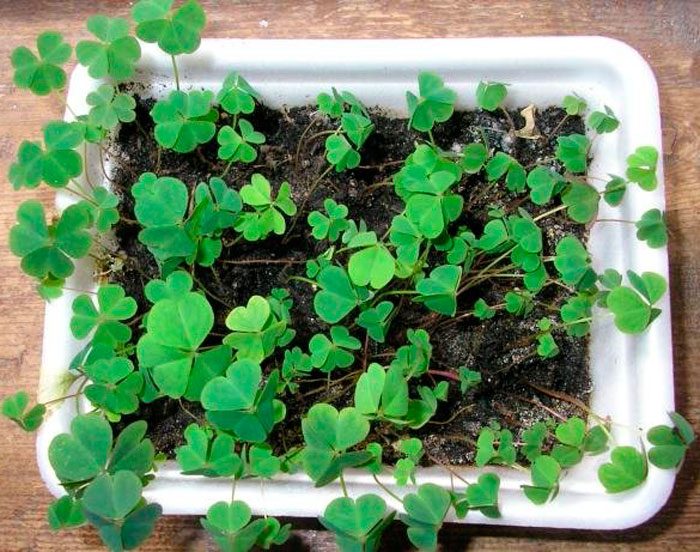
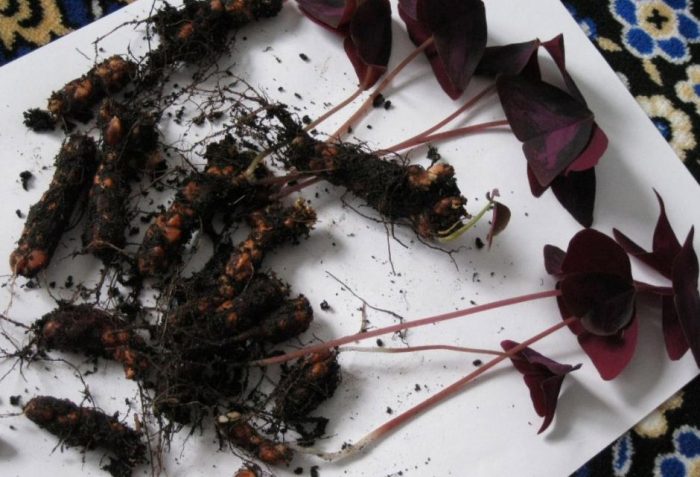
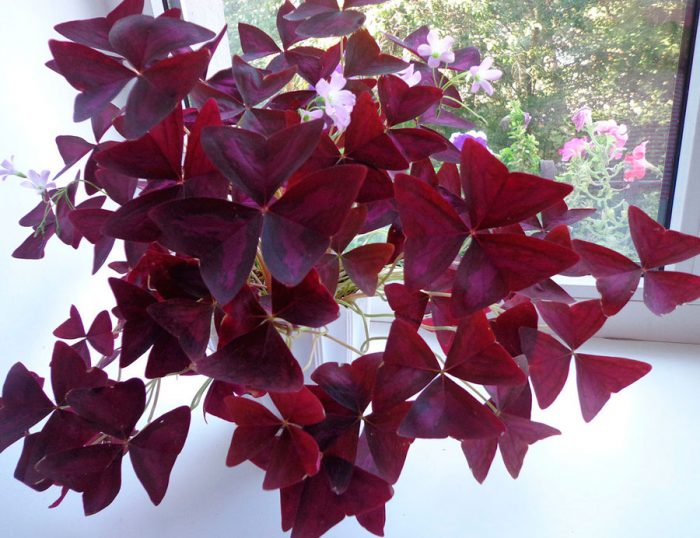
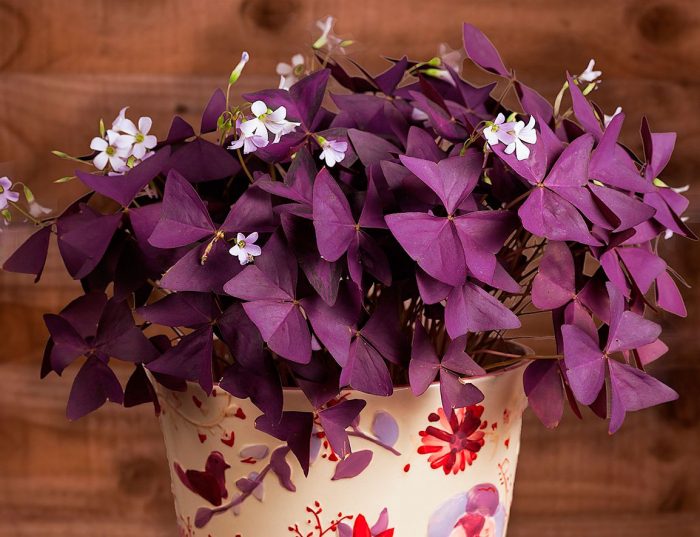
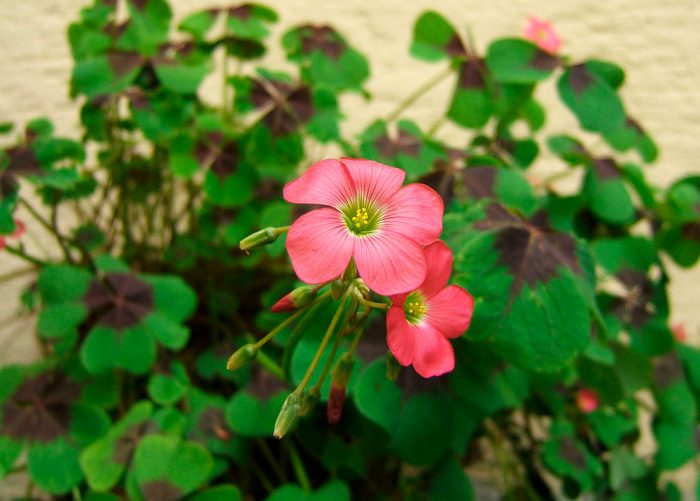
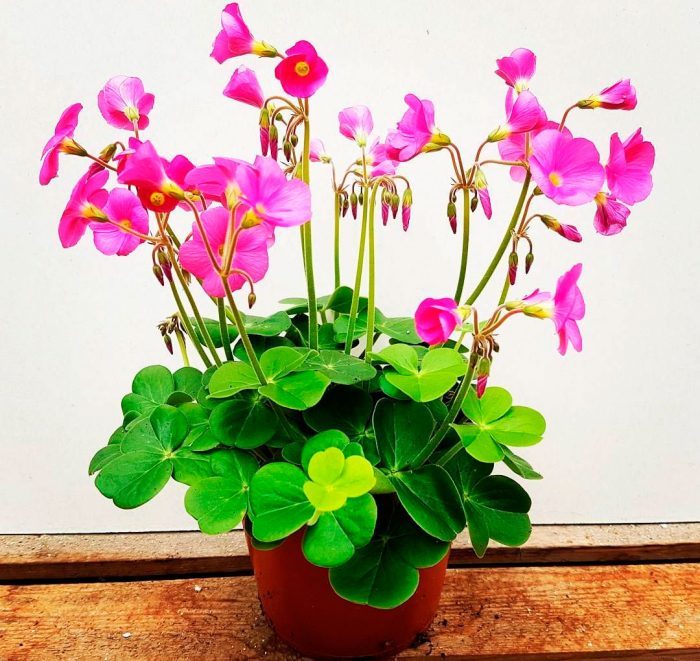

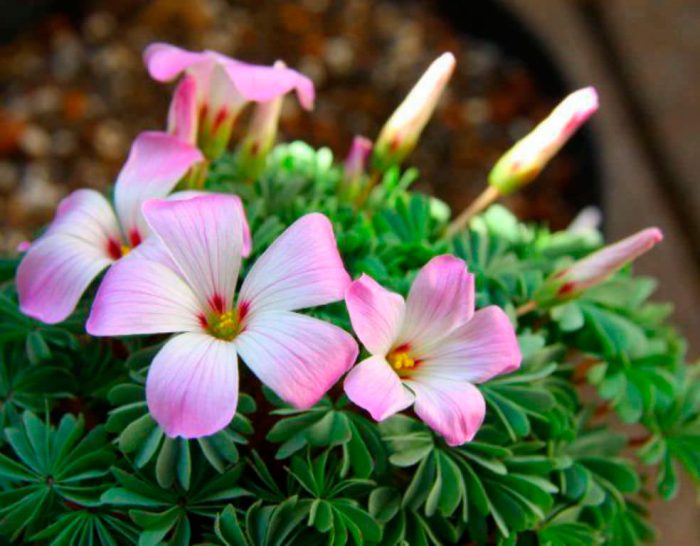
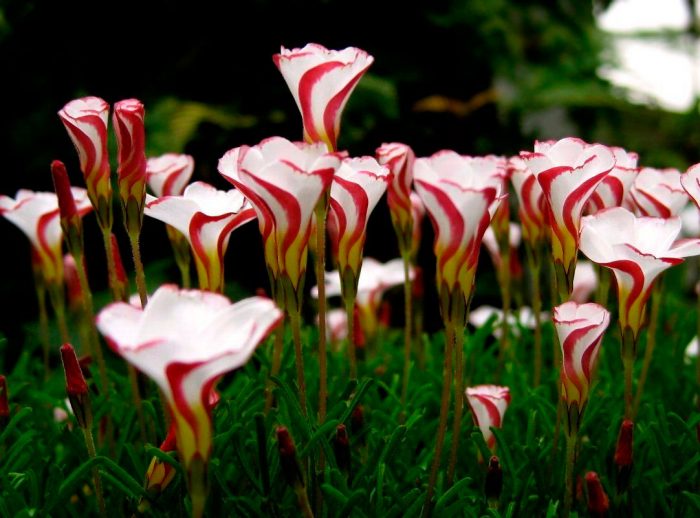










They gave me tubers, I dried them, after drying the tuber, if large, can be divided into 3-4 parts, they are easily separated by segments. It is even easier to plant without a leaf. It grows about one leaf per week.
I lay the nodules horizontally over the entire surface of the soil, sprinkle with earth, water, wait for the leaves.
A plant for the lazy, it requires almost no care.
I tried to plant it with a leaf, but not in sand, but in water, it did not work.